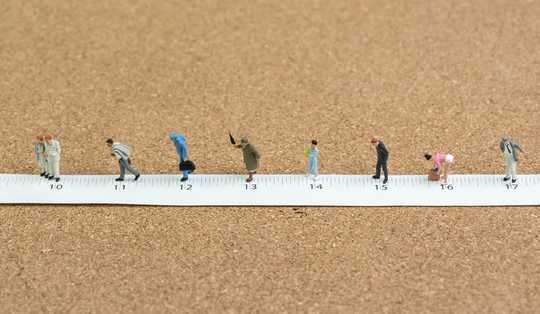What constitutes a safe distance when it comes to the spread of COVID-19? The answer depends on where you live.
China, Denmark and France recommend social distancing of one metre; Australia, Germany and Italy recommend 1.5 metres, and the US recommends six feet, or 1.8 metres. The UK, meanwhile, is reconsidering its relatively large two-metre distancing rule, but has attracted criticism from top scientists for doing so.
The truth is, we don’t yet know how far is far enough when it comes to coronavirus. A recent study found the virus in air as far as four metres away from infected patients in a COVID-19 ward. But another study, touted by the WHO, concluded that the risk of transmission becomes significantly lower with a distance of one metre or more from an infected person, reducing further with increased distance.
Why such a range of “safe” distances? That’s because social distancing is a complex problem with many variable influencing factors. Here are four of the most important ones.
Respiratory droplets
When we breathe, talk, cough and sneeze, thousands of droplets are expelled from our mouth and nose. The size of these droplets varies – some may be millimetres in size and some might be many thousands of times smaller. The larger droplets, which carry more virus particles, settle more quickly due to gravity. The smaller droplets, carrying fewer particles, can remain suspended in the air for hours.
The number and size of droplets vary depending on the activity. A cough produces more droplets overall and a greater proportion of them are larger. Breathing produces fewer droplets overall and they are generally smaller. The speed with which the droplets leave your mouth and nose also influences how far they travel – sneeze droplets will travel furthest.
Viral load
Viral load refers to the number of copies of the virus in a sample (for example, in the droplets that leave our mouth and nose). We know the number of virus copies in the respiratory samples of COVID-19 patients can vary from a few thousand to hundreds of billions per millilitre.
The viral load varies from one person to another, but also depends on what stage of the illness the patient is at. We also know that people without symptoms can shed the virus.
Knowing the viral load in respiratory droplets allows us to calculate how many virus particles people may be exposed to and whether this might be enough for them to become infected.
Infectious dose
The infectious dose is the number of copies of the virus that your body needs to be exposed to in order to develop an infection. When it comes to calculating a safe distance, the closer you are to an infected person, the more likely you are to be exposed to the infectious dose by breathing in virus-laden droplets.
The infectious dose for influenza strains varies from thousands to millions of copies. We do not yet know this number for SARS-CoV-2.
In time, further research on how the virus behaves in humans and other animals, and comparisons to other viruses will help to hone this number. In any case, we can be certain that the infectious dose will vary between different people.
The environment
Whether we are indoors or outdoors, in school, at work, on public transport or in the supermarket, the flow of air, ventilation, temperature and humidity will influence what happens to respiratory droplets.
 A lot depends on our environment when it comes to how water droplets spread. TravelerPix/Shutterstock
A lot depends on our environment when it comes to how water droplets spread. TravelerPix/Shutterstock
Air currents will blow droplets around in various directions. Good ventilation will dilute the number of droplets in the air. Temperature and humidity will affect the rate at which water evaporates from droplets. All this will affect our understanding of how much distance to keep in different types of space.
Complex scenarios
With these four elements, we can begin to put together what makes a safe distance.
Let’s start with this scenario: three people are in a room that is not ventilated. One of them is infected and two are not. One of the healthy people is standing closer to the infected person – for example, 80 centimetres away – and one is further away, say two metres.
The infected person coughs, producing a cloud of droplets. The larger droplets carrying more virus particles settle more quickly due to gravity. The smaller droplets carrying less virus travel further. So the person standing closer to the infected patient is at higher risk of being exposed to infectious droplets than the one standing further away.
Of course, the above scenario is overly simple. People move around. An open window may blow air in a particular direction. The infected person may cough repeatedly during a period of time. An air conditioner might recirculate air around a room. Room temperature and humidity may result in drying leading to smaller particles carrying higher concentrations of virus. Exposure to many smaller droplets over a longer period of time may be equivalent to exposure to a few larger ones in a short period.
There is an infinite number of scenarios and having one rule that applies to them all is impossible.
This means that different countries’ rules are, ultimately, best guesses made on the basis of some of the factors described above. They cannot apply in all contexts.
It is very unlikely that you would be exposed to infectious droplets outdoors because of rapid air flow and dilution, but enclosed crowded indoor spaces are much more of a risk. We all need to do our bit to stop the spread of coronavirus, so keep your distance, preferably as far as you can.![]()
About The Author
Lena Ciric, Associate Professor in Environmental Engineering, UCL
This article is republished from The Conversation under a Creative Commons license. Read the original article.
Related Books:
The Body Keeps the Score: Brain Mind and Body in the Healing of Trauma
by Bessel van der Kolk
This book explores the connections between trauma and physical and mental health, offering insights and strategies for healing and recovery.
Click for more info or to order
Breath: The New Science of a Lost Art
by James Nestor
This book explores the science and practice of breathing, offering insights and techniques for improving physical and mental health.
Click for more info or to order
The Plant Paradox: The Hidden Dangers in "Healthy" Foods That Cause Disease and Weight Gain
by Steven R. Gundry
This book explores the links between diet, health, and disease, offering insights and strategies for improving overall health and wellness.
Click for more info or to order
The Immunity Code: The New Paradigm for Real Health and Radical Anti-Aging
by Joel Greene
This book offers a new perspective on health and immunity, drawing on principles of epigenetics and offering insights and strategies for optimizing health and aging.
Click for more info or to order
The Complete Guide to Fasting: Heal Your Body Through Intermittent, Alternate-Day, and Extended Fasting
by Dr. Jason Fung and Jimmy Moore
This book explores the science and practice of fasting offering insights and strategies for improving overall health and wellness.






























